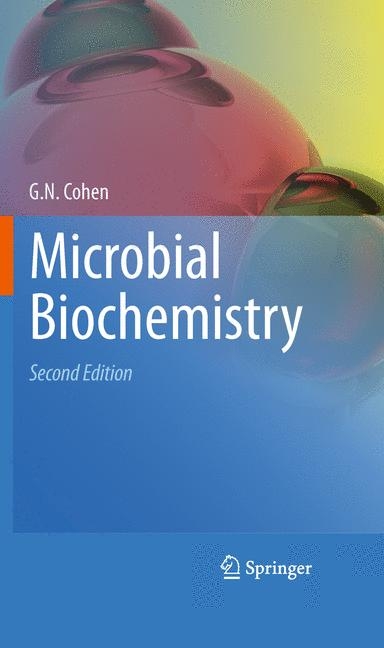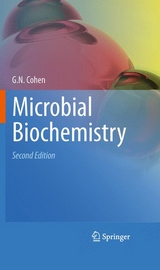Microbial Biochemistry
Seiten
2010
|
2nd ed. 2011
Springer (Verlag)
978-90-481-9436-0 (ISBN)
Springer (Verlag)
978-90-481-9436-0 (ISBN)
- Keine Verlagsinformationen verfügbar
- Artikel merken
Zu diesem Artikel existiert eine Nachauflage
Microbial Biochemistry describes biosynthetic pathways of microorganisme and their regulation by repression. Written in a three-part structure, the text explores the principles of bacterial growth, the biosynthesis of cell building blocks, and the study of protien-DNA interactions.
Microbial physiology, biochemistry, and genetics allowed the formulation of concepts that turned out to be important in the study of higher organisms. In the first section, the principles of bacterial growth are given, as well as the description of the different layers that enclose the bacterial cytoplasm, and their role in obtaining nutrients from the outside media through different permeability mechanism described in detail. A chapter is devoted to allostery and is indispensable for the comprehension of many regulatory mechanisms described throughout the book. Another section analyses the mechanisms by which cells obtain the energy necessary for their growth, glycolysis, the pentose phosphate pathway, the tricarboxylic and the anaplerotic cycles. Two chapters are devoted to classes of microorganisms rarely dealt with in textbooks, namely the Archaea, mainly the methanogenic bacteria, and the methylotrophs. Eight chapters describe the principles of the regulations at the transcriptional level, with the necessary knowledge of the machineries of transcription and translation.
The next fifteen chapters deal with the biosynthesis of the cell building blocks, amino acids, purine and pyrimidine nucleotides and deoxynucleotides, water-soluble vitamins and coenzymes, isoprene and tetrapyrrole derivatives and vitamin B12. The two last chapters are devoted to the study of protein-DNA interactions and to the evolution of biosynthetic pathways. The considerable advances made in the last thirty years in the field by the introduction of gene cloning and sequencing and by the exponential development of physical methods such as X-ray crystallography or nuclear magnetic resonance have helped presenting metabolism under a multidisciplinary attractive angle. The level of readership presupposes some knowledge of chemistry and genetics at the undergraduate level. The target group is graduate students, researchers in academia and industry.
Microbial physiology, biochemistry, and genetics allowed the formulation of concepts that turned out to be important in the study of higher organisms. In the first section, the principles of bacterial growth are given, as well as the description of the different layers that enclose the bacterial cytoplasm, and their role in obtaining nutrients from the outside media through different permeability mechanism described in detail. A chapter is devoted to allostery and is indispensable for the comprehension of many regulatory mechanisms described throughout the book. Another section analyses the mechanisms by which cells obtain the energy necessary for their growth, glycolysis, the pentose phosphate pathway, the tricarboxylic and the anaplerotic cycles. Two chapters are devoted to classes of microorganisms rarely dealt with in textbooks, namely the Archaea, mainly the methanogenic bacteria, and the methylotrophs. Eight chapters describe the principles of the regulations at the transcriptional level, with the necessary knowledge of the machineries of transcription and translation.
The next fifteen chapters deal with the biosynthesis of the cell building blocks, amino acids, purine and pyrimidine nucleotides and deoxynucleotides, water-soluble vitamins and coenzymes, isoprene and tetrapyrrole derivatives and vitamin B12. The two last chapters are devoted to the study of protein-DNA interactions and to the evolution of biosynthetic pathways. The considerable advances made in the last thirty years in the field by the introduction of gene cloning and sequencing and by the exponential development of physical methods such as X-ray crystallography or nuclear magnetic resonance have helped presenting metabolism under a multidisciplinary attractive angle. The level of readership presupposes some knowledge of chemistry and genetics at the undergraduate level. The target group is graduate students, researchers in academia and industry.
| Erscheint lt. Verlag | 27.10.2010 |
|---|---|
| Zusatzinfo | 135 black & white illustrations, 6 colour illustrations, biography |
| Verlagsort | Dordrecht |
| Sprache | englisch |
| Maße | 156 x 234 mm |
| Gewicht | 995 g |
| Themenwelt | Medizin / Pharmazie ► Medizinische Fachgebiete ► Mikrobiologie / Infektologie / Reisemedizin |
| Studium ► 1. Studienabschnitt (Vorklinik) ► Physiologie | |
| Naturwissenschaften ► Biologie ► Biochemie | |
| Naturwissenschaften ► Biologie ► Mikrobiologie / Immunologie | |
| Naturwissenschaften ► Biologie ► Zellbiologie | |
| ISBN-10 | 90-481-9436-9 / 9048194369 |
| ISBN-13 | 978-90-481-9436-0 / 9789048194360 |
| Zustand | Neuware |
| Informationen gemäß Produktsicherheitsverordnung (GPSR) | |
| Haben Sie eine Frage zum Produkt? |
Mehr entdecken
aus dem Bereich
aus dem Bereich





